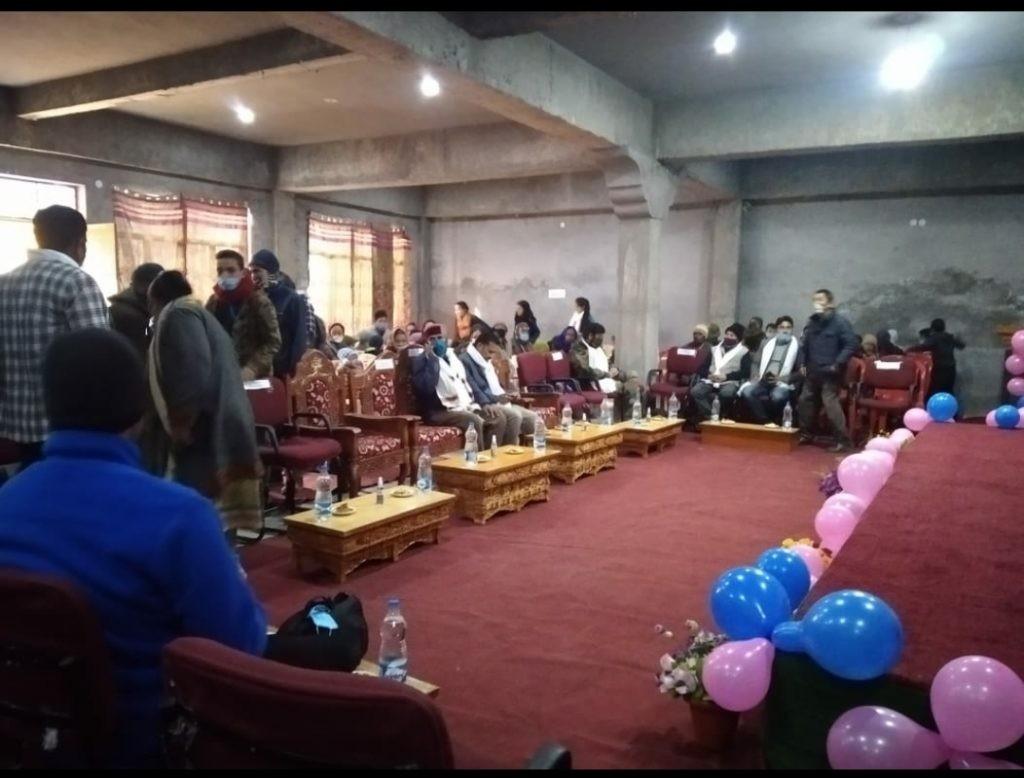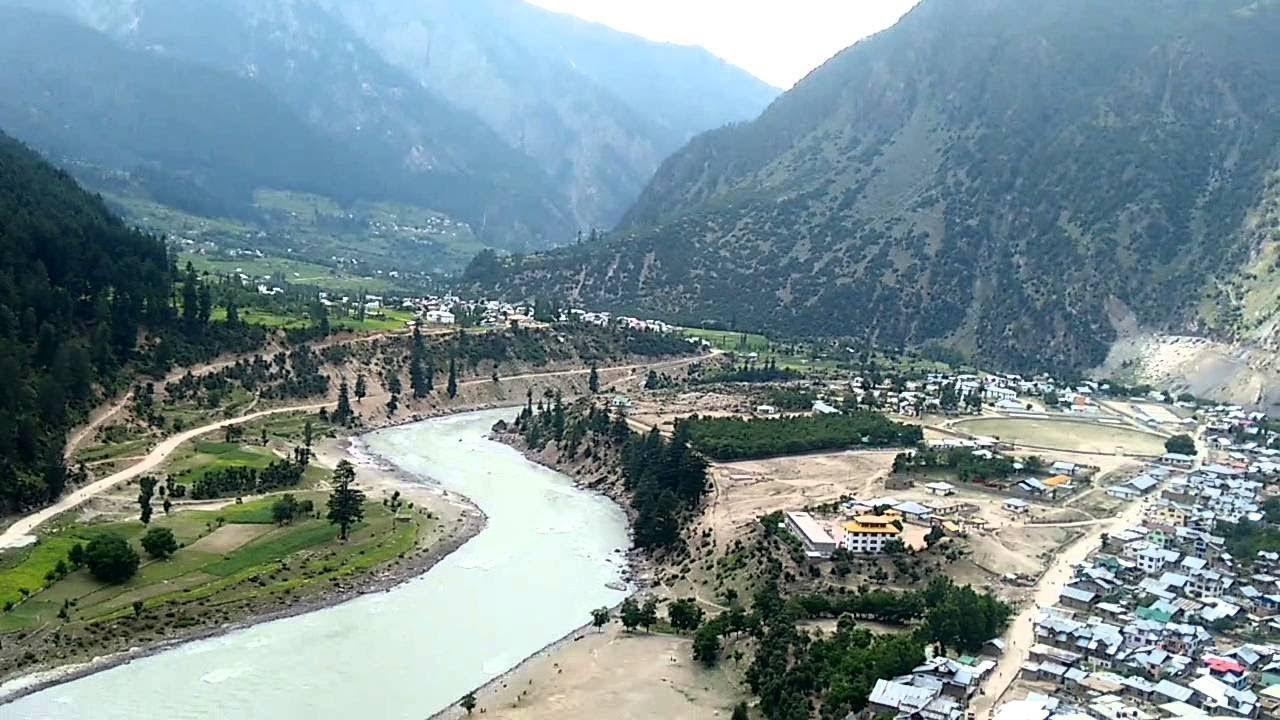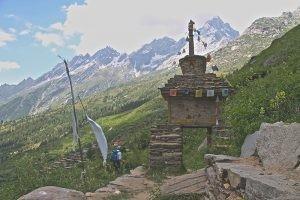
11 minute read
Changes in LOSAR with time.
But the trend of celebrations is changing day by day. With the passage of time the week long celebrations of Losar has now been reduced to a day. Exhibition of our cultural heritage through very ancient rituals and traditional performances are now becoming extinct. Participation of people in the celebrations is decreasing nowadays. The value and importance of the festival Losar in Paddar valley has now remained only as a source of entertainment and enjoyment. The celebration of Losar which was once the celebration of whole community, engagement of all men, women and children, exchange of best wishes among the village has now reduced to few families and relatives. In fact the celebration of the festival has now become a thing of past.
With the advent of television, mobile phones and internet services in Paddar in the past decade, a drastic change in the celebration of Losar has crept in the society which is not a good sign. Use of other languages instead of our own in our houses and community, focusing our mind on other culture by watching TV shows, paying attention more on fantasies has now changed and mind-set of our generations.
Advertisement
All these changes with the advent of modernization have helped us all to develop educationally and financially but on the other hand have degraded us morally, ethically and traditionally. We all should focus on the preservation and promotion of our cultural identity. Otherwise in the near future practices like celebration of Losar and other ancient rituals which we got from our forefathers will just remain in our stories.
Promotion and way forward
There are some positive signs in the preservation and promotion of our cultural heritage also. Gandhari village which I think is educationally the most backward among other Buddhist belonging villages is the best example where the villagers both men and women are still seen in their traditional attires at every occasion. It is indeed a good sign. Thanks to the people of Gandhari valley who being cut off from the rest of Paddar valley have still kept their identity intact. Thanks also to the APBSWA, the Buddhist Student Association in Jammu for extending its hands in the promotion of Losar festival during past few years. APBSWA is doing a remarkable job in this regard by providing platform to our young artists to exhibit our culture through cultural songs and dances.
Inauguration of first ever Annual Cultural Festival by his Holyness the 12th Gyalwang Drukpa on 22nd of July, 2018 was a revolutionary step towards cultural promotion and preservation. The said cultural festival has revolutionized the whole society. People are now understanding the value of our cultural heritage.
Poets and Lyricists like Master Des Raj and Nomo Padma Tsomo have started composing poems and songs in Paddri language. Artists like Nomo Tsering Tolma, Nomo Tsewang Palmo, Nomo Tashi Dorjee and Nomo Padma Tsomo are coming forward in promoting our culture. First ever musical album ‘Paddar Ldumra” released on the occasion of first annual Paddar Cultural Festival by Himalayan Buddhist Cultural Society Gulabgarh Paddar and live performances by our young artists like Tashi Rock, Tsering Tolma and Tsewang Palmo on international level high voltage stage at Naro Festival Ladakh, India, are some of the live examples which have given new wings to our culture to flourish and new trajectory to our culture to develop. Each and every one of us should take responsibility and play an active part in the cultural transformation. Young and educated class of the society should come forward and extend their hands in transforming the society towards cultural preservation.
Paddari language belongs to western Pahari sub-group of Indo- Aryan language family. It is primarily spoken in Padder area of District. Kishtiwar of Jammu
Jaswant Singh
Padri is a Pahari dialect spoken in Paddar valley of district Kishtwar located on south-eatern side touching its borders with Pangi (Himachal Pradesh), Zanskar valley of Ladakh & Marwah-Wadwan Valley. It is the child dialect of Bhaderwahi group which includes three dialects viz. bhaderwahi, bhalesvi and padri. It has been placed under Indian Indo-Aryan language family and is one of the offshoots of western Pahari language. It has been influenced by the common speech of people living in her neighbourhood viz. Pangwali and Bhaderwahi significantly.
As far as present status of the Padri dialect is concerned, there are less than 15000 speakers who speak Padri as their mother tongue and the number of speakers is decreasing on an alarming rate. It is facing crisis mostly in the last two decades and heading towards extinction along with its culture. Given the critical status of the dialect, it has been included in vulnerable category of languages in 2014 by Ministry of Minority Affairs, Government of India.
Its status has further been substantiated by a survey conducted in 2015 by scholars of Department of linguistic studies, University of Kashmir. In the survey, it was found that 70% of the population speak in Padri at home while rest communicates in dominant and other specific languages. It is quite clear that there is significant decrease in percentage of its use. Some 60 % parents speak in Padri to their children today while communicating with grandparents it is 80%. As regards use of Padri in school, 50% of communication with the teachers in the classroom takes place in Padri, 37% in dominant language (Hindi/ Urdu) while 13 % in other language. Moreover, 80% people use Padri in market for buying/selling things. Only 5% converse in dominant language with the merchants of the same tribe/community and 5% converse in other languages. In the same way, 75% converse in Hindi/Urdu with the merchants of the other community/tribe. In temples, 85 % of praying to gods takes place in the dominant language (Hindi), 10% in Paddari while only 5% in other languages. In the paddar, Padri is the prominent language therefore most of the religious songs are composed in Padri and 75% singing of religious songs take place in Padri, 15% in Hindi and 10% in other languages. At the place of worship, different people communicate in different languages, however if people know one another, they speak in their mother tongue. Unknown ones usually speak in Hindi. It was found that 60% talking at religious places takes place in Padri and 40% in Hindi. Many factors are contributing towards endangered status of Padri: communication with outside regions, migration of people for education and job who end up losing the connection with it, globalization, influence of dominant language (which is considered as a political symbol of nation, symbol of civilization and progress), the stigmatization of a local dialect (low prestige of the endangered dialect), lack of physical proximity among speakers, the desire for literacy, a law of compulsory education in a specific language, a lack of social cohesion among speakers, cultural destruction and neglect (medium of instruction is only the dominant language), parents switching to the dominant language because they think that their children won’t get the best opportunities learning their native dialect, too much of outside influence is diminishing the culture and tradition of Paddar, negligence and faulty provisions of the governance which have not facilitated our mother tongue to be functional and not useful outside the home domain, trend of mixing languages and this is mainly because youth think that talking in native languages will sound rural and rustic, due to the lack of intergenerational transmission and decrease in domains of its use. This presents a frightening scenario as the dialect could be on its path to extinction. We do not seem to have woken up to the harsh reality and no proper steps have been initiated by either the community or government of J&K to save the dying dialect. This dialect has already been listed by government of India. If the current trend continues, most probably it would become extinct by the end of century.
Some might assume that the disappearance of this dialect is the concern of only a few scholars and a tragedy only for linguists. However, this view would be mistaken. Its loss will affect us and our community in acute ways. Its loss is typically a loss of our social identity. Our psychological and social wellbeing is connected with it; it shapes our values, self-image, identity, relationships, and ultimately success in life. It is the treasure house of information of our history, literature and art. Its stories, ideas, and words help us make sense of our own lives and of the world around us-of the human experience, and of the human condition in general. If it becomes extinct without documentation, it will take all its oral literature, oral tradition, and oral history into oblivion. It is great reservoir of historical information, information about how we are related, our contacts and migrations, our homeland and past culture. With its extinction, all this information and other insights into shared human experiences are irretrievably lost. The loss of literature and historical information means loss in the range of potential ways of experiencing and understanding the world. It constitutes one of the greatest treasures of our ancestors. Its loss will lead to reduction of our adaptational strength of our community because it lowers the pool of knowledge. It will leave human survival in jeopardy because of the loss of knowledge of alternative food sources. If it becomes extinct, knowledge of the medicinal plants will be lost.
It is time the community based organizations including the student wings of Paddar and Government should take steps before it’s too late. The community based organizations can play big role in this regard. They need to shed their egos and come together to work unitedly to save the dying dialect. It gives us the responsibility to act rather than sit by and watch the precipitous loss of this intangible linguistic heritage. We must: convince the community of the worth of its dialect, promote consciousness of the catastrophic effects of loss of the dialect among its speakers (and those whose heritage language it is) and among members of the mainstream population, especially leaders and policy makers, re-establish pride in and value for the dialect, obtain collaboration from many people and organizations (parents, government officials, community leaders, and even linguists) to work together for the success of dialect maintenance projects, document the dialect by way of using either Devnagri or Persian script to write grammar and multilingual dictionary of Padri dialect, establish community Radio, publish magazines and books in Padri dialect and use Padri in communication on social sites
Often a language is pushed out of use before scholars and language community have a chance to document or preserve this linguistic heritage. Our community is recognised by the padri dialect as it is a part of our custom and tradition. It is not natural but man-made and comes out of great human labour. Thousands of years have been spent before it is born. If we lose it, we are doing grave injustice to our predecessors and ancestors.
Of the estimated 7000 languages spoken in the world today, linguists say nearly half are in danger of extinction and likely to disappear in this century. In fact one falls out of use about every two weeks.
Some languages vanish in a second, at the death of sole surviving speaker. According to a survey conducted by Bhasha Research and publication centre, India had in the 1960’s 1100 languages out of which 220 have disappeared by now. If we do not awake from the deep slumber, the Padri dialect is unlikely to maintain its existence in foreseeable future. feedbackexcelsior@gmail.com


Visits of various Rinpoches to Paddar Valley:-
Since time immemorial, various religious gurus eminent personalities have been visiting the valley of Sapphire (Paddar) but least concrete information about their visits is available.
But when we approached senior persons of Paddar valley, we came to know that since 1987, when the foundation of Himalayan Buddhist Cultural Society was laid down, various religious gurus have visited Paddar valley and we have tried to put them in chronological order as under:
MONTH & YEAR
1) JULY 1987
2) JULY 1995
3) JULY 1998
4) JULY 1999
5) October 2000
Eminent Personalities
H.H Jabdrung Rinpoche visited the Paddar valley on foot & blessed all the Buddhist communities of Paddar.
H.E the 19th Lochal Tulku Rinpoche visited Gulabgarh Paadar & other adjoining villages. H.E laid the foundation of HCS( Himalayan Cultural School) at Gulabgarh.
Ven Jigmet Khunu Rinpoche visited Paddar Valley.
Ven Jigmet Khunu Rinpoche visited Paddar Valley for the second time.
H.E Kyabje Stakna Rinpoche at the age of 80 years visited Paddar valley and donated Rs.50000.0 to the school for its smooth running.
6) JUNE 2001
7) October 2002
8) JULY 2006
H.E Choeje(Dharana Master) Togden Rinpoche visited Paddar valley and blessed the people of valley . H.E also donated rs. 10000.00 for the HCS.
H.E Kyabje Stakna Rinpoche visited Paddar valley for 2nd time.
H.E Kyabje Stakna Rinpoche Paddar valley for the 3rd time and also donated Rs.50000.0 to the school .
9) JUNE 2010 H.H the 14th Dalai Lama visited Paddar Valley.
10) October 2013
H.E kyabje Choegon Rinpoche visited Paddar valley and stayed at Gulabgarh fotang for a two days religious teaching organised by Youth Association.
11) JULY 2018
4 Gurus, H.E the 12 Kybgon Galwang Rinpoche, H.E Drukpa Takna Rinpoche, H.E Thuksey Rinpoche and H.E Khamta Rinpoche visited Paddar
Dalai Lama in Paddar Valley, Kishtwar:
The Tibetan Buddhist spiritual leader arrived here at Gulabgarh Paddar on his 2 day visit to the Sapphire Valley on mountainous Kishtwar District amid tight security arrangements and was received by the Chief Minister Omar Abdullah along with his 3 cabinet colleagues G.M Saroori ( R&B Minister),
Nawang Rigzin Jora ( Tourism & Culture Minister), Qamar Ali Akhoon ( Minister CAPB), Chaudhry Lal Singh( M.P) & Sajjad Ahmed Kichloo. This was the first visit of the H.H the 14th Dalai Lama to the Jammu region of the state. Media persons from different parts of the country reached Paddar valley to cover the moment of the religious congregation organized by Himalayan Buddhist Cultural Society, Paddar under the leadership of Jigmet Norbu.
For the past 15 years , the Buddhist community of Paddar in general & HBCS in in particular was consistently approaching H.H the Dalai Lama to visit Paddar to address the congregation of Buddhist population and now the dreams of the people of the valley is fulfilled.
Click here for Paddar Sapphire Mines: A million dollar Industry in J&K
H.H the 14th Dalai Lama addressed a gathering of about 10000 people from different parts of the country in the Chattergarh Stadium Gulabgarh. Prior to the visit of H.H to Paddar, the people were expecting few political announcements, but when H.H delivered his speech, it was purely nonpolitical. However he said, “I believe myself to be India’s messenger to the world, the listeners got attentive, there was a pin drop silence in the open ground. His another statement ‘India & Tibet have always had a “Guru Shishya relationship”. I am thus a chela of India.
Buddhist Stupa in Paddar
In fact, H.H all the statements were all about peace and brotherhood. While addressing the public gathering, H.H appealed the world leaders to come forward and make the 21st century, violence free. Admiring the social fabric in India where people following different faiths live together peacefully. H.H said that peace is one of the highest virtues and this should lead to the unity of hearts among people of all faiths. H.H appealed the people to continue with their rich multicultural heritage and maintain religious harmony and tranquility at all costs. H.H also said that he was fortunate to have friendship with three generations of Abdullah Family.
Click here to know about Religious Tourism in Paddar

Before leaving H.H advised the gathering in the ground of the main temple to follow Buddhism practically for humanity and non-violence. H.H also advised to preserve the rare holy Buddhist texts Kengur & Tengur and maintain peace and harmony with other religious faiths of the valley. He also donated Tengur for the monastery and & provided financial assistance for the smooth functioning of the Himalayan Cultural School and Hostel.
All the local people of Paddar valley were chanting mantras with holding colourful khataks in their hands while H.H was leaving to Dharamshala (HP). They were both sad and happy, sad because H.H was leaving & happy because the decade long dream of the people of Paddar was fulfilled.





